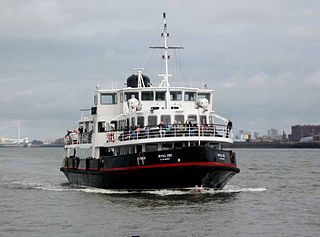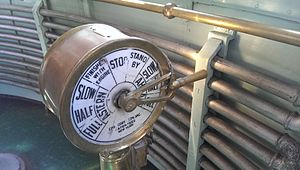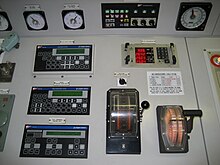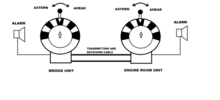
Seamanship is the art, knowledge and competence of operating a ship, boat or other craft on water. The Oxford Dictionary states that seamanship is "The skill, techniques, or practice of handling a ship or boat at sea."

The MV Andrew J. Barberi is one of two Barberi-class ferry boats operated as part of the Staten Island Ferry between Manhattan and Staten Island in New York City, besides MV Samuel I. Newhouse. With a capacity of 6,000, she is among the highest-capacity boats in the ferry's fleet. Since her introduction in 1981, she has had a history of incidents, including a 2003 crash that killed eleven people and a 2010 crash that injured thirty-seven.

A bridge, also known as a pilothouse or wheelhouse, is a room or platform of a ship from which the ship can be commanded. When a ship is under way, the bridge is manned by an officer of the watch aided usually by an able seaman acting as a lookout. During critical maneuvers the captain will be on the bridge, often supported by an officer of the watch, an able seaman on the wheel and sometimes a pilot, if required.

A conning tower is a raised platform on a ship or submarine, often armoured, from which an officer in charge can conn the vessel, controlling movements of the ship by giving orders to those responsible for the ship's engine, rudder, lines, and ground tackle. It is usually located as high on the ship as is practical, to give the conning team good visibility of the entirety of the ship, ocean conditions, and other vessels.

MV Royal Daffodil is a former ferry based on the River Mersey, England. From launch until a major refit in 1998 /1999, she was named MV Overchurch, she began service for Birkenhead Corporation Ferries in 1962 and was in regular service on the river until her withdrawal in December 2012. Despite her extensive re-build in 1999, the ship still retains a similar profile to that of her original design. After her withdrawal, the vessel remained idle since her dry docking and survey in January 2013. In April 2019 a new home was confirmed for the ship in the form of a new floating leisure attraction, in Liverpool's Canning Dock.
An officer of the deck (OOD) underway is a watchstanding duty officer on a surface ship in the United States Navy, United States Coast Guard, and NOAA Commissioned Officer Corps who is tasked with certain duties and responsibilities for the ship. The officer of the deck is either subordinate to the command duty officer or, in the absence of one, reports directly to the ship's commanding officer and executive officer, in the latter case holding responsibility for the ship altogether. This article describes duties and responsibilities for an underway OOD for surface ships only.

Astern propulsion is a maneuver in which a ship's propelling mechanism is used to develop thrust in a retrograde direction. Astern propulsion does not necessarily imply the ship is moving astern ; astern propulsion is used to slow a ship by applying a force in the direction of the bow of the ship, instead of the stern. The equivalent concept for an airplane is thrust reversal.

The Kitchen rudder is the familiar name for "Kitchen's Patent Reversing Rudders", a combination rudder and directional propulsion delivery system for relatively slow speed displacement boats which was invented in the early 20th century by John G. A. Kitchen of Lancashire, England. It turns the rudder into a directional thruster, and allows the engine to maintain constant revolutions and direction of drive shaft rotation while altering thrust by use of a control which directs thrust forward or aft. Only the rudder pivots; the propeller itself is on a fixed shaft and does not.

The MV George Prince ferry disaster was a nautical disaster that occurred in the Mississippi River in St. Charles Parish, Louisiana, United States, on the morning of October 20, 1976. The Luling–Destrehan Ferry George Prince was struck by the Norwegian tanker SS Frosta, which was traveling upriver. The collision occurred at mile post 120.8 above Head of Passes, less than three-quarters of a mile from the construction site of the Luling Bridge which would replace the ferry seven years later. The ferry was crossing from Destrehan, Louisiana on the East Bank to Luling, Louisiana on the West Bank. Ninety-six passengers and crew were aboard the ferry when it was struck, and seventy-eight perished. This accident is the deadliest ferry disaster in United States history. It is also the deadliest peacetime nautical disaster involving a non-submersible vessel in U.S. waters since the explosion of the SS Grandcamp in 1947, which killed 581 people. In addition, it is the deadliest accident involving a single vessel in U.S waters since a fire on board the SS Morro Castle in 1934, which killed 137 people.

The harbour defence motor launch (HDML) was a 72 ft (22 m) long British-designed motor vessel used for harbour defence during World War II. Nearly 500 were built by numerous Allied countries during the war.
Flank speed is an American nautical term referring to a ship's true maximum speed but it is not equivalent to the term full speed ahead. Usually, flank speed is reserved for situations in which a ship finds itself in imminent danger, such as coming under attack by aircraft. Flank speed is very demanding of fuel and often unsustainable because of propulsion system limitations. The related term emergency may not be any faster than flank but it indicates that the ship should be brought up to maximum speed in the shortest possible time.

The MV Royal Iris of the Mersey is a Mersey Ferry in operation on the River Mersey, England. From launch in Devon in 1959 until a major refurbishment in 2001, she was named MV Mountwood.

Ship gun fire-control systems (GFCS) are analogue fire-control systems that were used aboard naval warships prior to modern electronic computerized systems, to control targeting of guns against surface ships, aircraft, and shore targets, with either optical or radar sighting. Most US ships that are destroyers or larger employed gun fire-control systems for 5-inch (127 mm) and larger guns, up to battleships, such as Iowa class.
There are two different meanings to the term lee helm depending on whether one is discussing sailboats or motorized ships.

Sioux was a steamship which was operated on Puget Sound and the Strait of Juan de Fuca from 1912 to 1941. From 1924 to 1941, following reconstruction, the vessel operated as an auto ferry under the name Olympic. During the Second World War (1941-1945) this vessel was taken under the control of the U.S. Army and renamed the Franklin R. Leisenburg. The Liesenburg served as a ferry in the Panama Canal area under Army control, and then was sold to a firm which ran the vessel on the Surinam river in South America.

Camano was a steamboat built in 1906 at Coupeville, Washington which operated on Puget Sound from 1906 to 1917. Camano was later known as Tolo. As Tolo the vessel was sunk in 1917 as a result of a collision at sea. Four people died as a result.

TSS (RMS) Mona's Queen (III) No. 145308, was a ship built for the Isle of Man Steam Packet Company in 1934. The steamer, which was the third vessel in the company's history to bear the name, was one of five ships to be specially commissioned by the company between 1927 and 1937. They were replacements for the various second-hand steamers that had been purchased to replace the company's losses during the First World War. However, the life of the Mona's Queen proved to be short: six years after being launched she was sunk by a sea mine during the Dunkirk evacuation on 29 May 1940.

SS (RMS) Peveril (I) No. 76307 – the first vessel in the company's history to be so named – was a packet steamer which was operated by the Isle of Man Steam Packet Company until she sank off Douglas following a collision with SS Monarch in 1899.

SS Maloja was an M-class passenger steamship of the Peninsular and Oriental Steam Navigation Company. She was completed in 1911 and worked a regular route between Great Britain and India. In 1916 in the First World War she was sunk by a mine in the English Channel off Dover with the loss of 155 lives.

The sinking of HMS Victoria took place at approximately 15:30 on 22 June 1893, after HMS Victoria, the flagship of the Royal Navy's Mediterranean Fleet, collided with HMS Camperdown while on fleet manoeuvres in the Eastern Mediterranean. The collision caused significant damage to Victoria's bow, with a large hole produced causing the ship to rapidly capsize. Victoria took approximately fifteen minutes to sink, with 358 members of the crew, including Vice-Admiral Sir George Tryon, lost in the disaster.




















